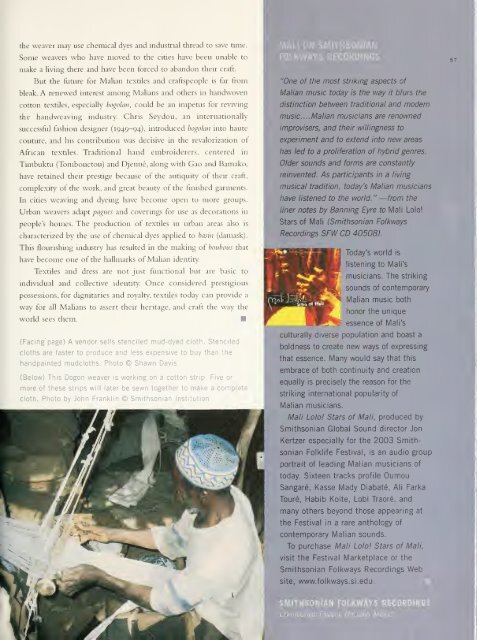SCOTLAND - Smithsonian Digital Repository - Smithsonian Institution
SCOTLAND - Smithsonian Digital Repository - Smithsonian Institution
SCOTLAND - Smithsonian Digital Repository - Smithsonian Institution
You also want an ePaper? Increase the reach of your titles
YUMPU automatically turns print PDFs into web optimized ePapers that Google loves.
the weaver may use chemical dyes and industrial thread to save time.<br />
MALI ON SMITHSONIAN<br />
Some weavers who have moved to the cities<br />
have been unable to<br />
make a hving there and have been forced to abandon their craft.<br />
But the future for Malian textiles and craftspeople is far from<br />
bleak. A renewed interest among Mahans and others in handwoven<br />
cotton textiles, especially hogolan, could be an impetus for reviving<br />
the handweaving industry. Chris Seydou, an internationally<br />
successfiil fashion designer (1949—94), introduced bogolan into haute<br />
couture, and his contribution was decisive in the revalorization ot<br />
African textiles. Traditional hand embroiderers, centered in<br />
Timbuktu (Tombouctou) and Djenne, along with Gao and Bamako,<br />
have retained their prestige because of the antiquity of their craft,<br />
complexity of the work, and great beauty of the finished garments.<br />
In cities weaving and dyeing have become open to more groups.<br />
Urban weavers adapt pagnes and coverings for use as decorations in<br />
people's homes. The production of textiles in urban areas also is<br />
characterized by the use of chemical dyes appHed to basin (damask).<br />
This flourishing industry has resulted in the making of boubous that<br />
have become one of the hallmarks of Mahan identity.<br />
Textiles and dress are not just functional but are basic to<br />
individual and collective identity. Once considered prestigious<br />
possessions, for dignitaries and royalty, textiles today can provide a<br />
way for aU Mahans to assert their heritage, and craft the way the<br />
world sees them.<br />
(Facing page) A vendor sells stenciled mud-dyed cloth. Stenciled<br />
cloths are faster to produce and less expensive to buy than the<br />
handpainted mudcloths. Photo © Shawn Davis<br />
(Below) This Dogon weaver is working on a cotton strip. Five or<br />
more of these strips will later be sewn together to make a complete<br />
cloth. Photo by John Franklin © <strong>Smithsonian</strong> <strong>Institution</strong><br />
"One of the most striking aspects of<br />
Malian music today is ttie way it blurs the<br />
distinction between traditional and modern<br />
music. ...Malian musicians are renowned<br />
improvisers, and their willingness to<br />
experiment and to extend into new areas<br />
has led to a proliferation of hybrid genres.<br />
Older sounds and forms are constantly<br />
reinvented. As participants In a living<br />
musical tradition, today's Malian musicians<br />
have listened to the world. "<br />
— from the<br />
liner notes by Banning Eyre to Mali Lolo!<br />
Stars of Mali (<strong>Smithsonian</strong> Folkways<br />
Recordings SFW CD 40508).<br />
Today's world is<br />
listening to Mali's<br />
musicians. The striking<br />
sounds of contemporary<br />
Malian music both<br />
honor the unique<br />
f* essence of Mali's<br />
culturally diverse population and boast a<br />
boldness to create new ways of expressing<br />
that essence. Many would say that this<br />
embrace of both continuity and creation<br />
equally is precisely the reason for the<br />
striking international popularity of<br />
Malian musicians.<br />
Mali Lolo! Stars of Mali, produced by<br />
<strong>Smithsonian</strong> Global Sound director Jon<br />
Kertzer especially for the 2003 <strong>Smithsonian</strong><br />
Folklife Festival,<br />
is an audio group<br />
portrait of leading Malian musicians of<br />
today. Sixteen tracks profile Gumou<br />
Sangare, Kasse Mady Diabate, Ali Farka<br />
Toure, Habib Koite, Lobi Traore, and<br />
many others beyond those appearing at<br />
the Festival in a rare anthology of<br />
contemporary Malian sounds.<br />
To purchase Mali Lolo! Stars of Mali,<br />
visit the Festival Marketplace or the<br />
<strong>Smithsonian</strong> Folkways Recordings Web<br />
site,<br />
www.folkways.si.edu.<br />
SMi1Wip||||pn.KWAYS RECORDINGS<br />
Connecting People through Music
















